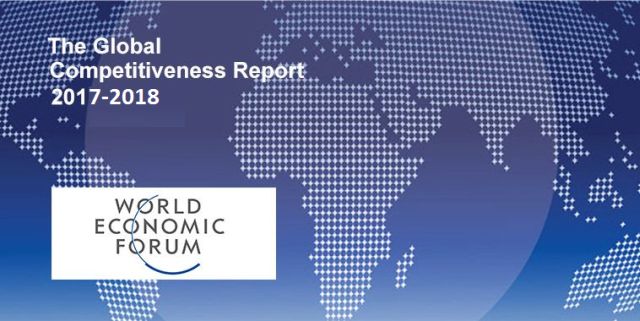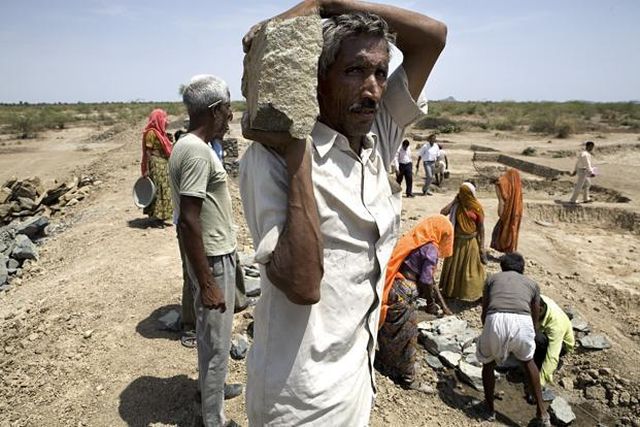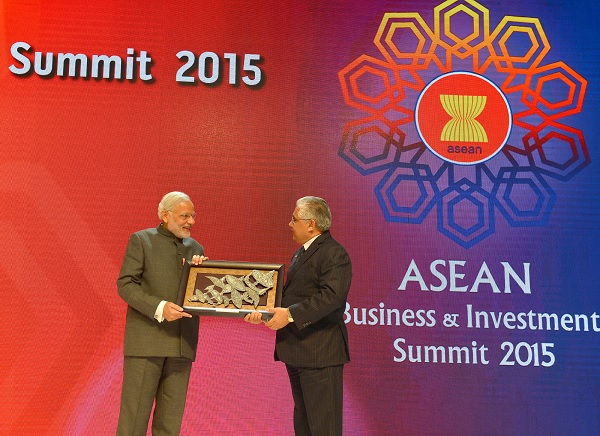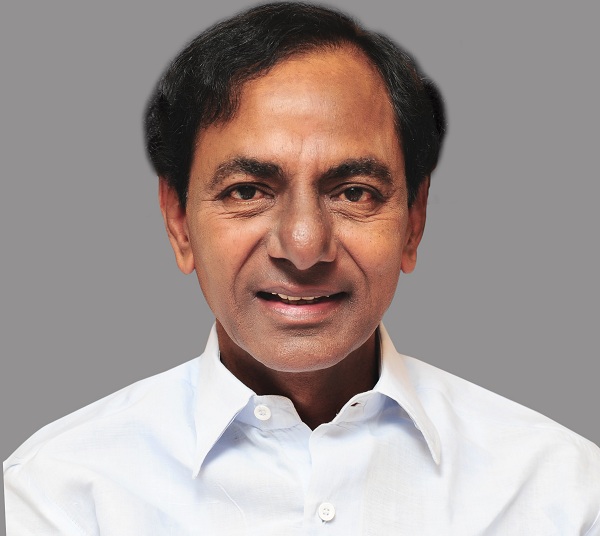
by Editor | May 25, 2021 | Opinions
 By Amit Kapoor,
By Amit Kapoor,
In a respite to the Modi government, which has been facing the heat over dismal economic numbers, the World Economic Forum (WEF) study on global competitiveness for 2017 commended the improving quality of institutions in India, especially in terms of improved efficiency of public spending in the last few years. This was despite the fact that India slipped a place to rank 40 out of a total 137 countries in the Global Competitiveness Index 2017-18.
However, the WEF has clarified that it has changed its methodology this year and the rankings are not comparable with those of last year. Moreover, it also pointed out that this is India’s highest score ever with the new methodology (4.6 compared to 4.5 in the previous year). The country’s score has improved across most indicators of competitiveness, especially infrastructure (66th, an improvement of two points over last year), higher education and training (75th, up six) and technological readiness (107, up two), which is a reflection of recent public investment in these areas.
India has also ranked the highest among all South Asian countries with the next highest being Bhutan and Sri Lanka ranked at 85. Among the BRICS nations, China (27) and Russia (38) rank above India while South Africa and Brazil are placed at 61 and 80. In a major hopeful boost to the dwindling India growth story, the report stated that among the emerging markets that were seen to have great potential in the early 2000s, Brazil and Turkey have lost much of what they had gained before 2013, while China, India and Indonesia continue to grow strong.
The report also gives some useful insights about the growth trends of the Indian economy. First, among the emerging economies, it finds that India and China are gradually developing into major centres of innovation. In a recent study of geographical clusters generating the most patents, three Indian cities appeared in the top 100 with Bengaluru at 43 (with patent activity focused on computer technology), Mumbai at 95 and Pune at 96 (with both registering among the most patents in organic chemistry). Due to such an improvement in the innovative environment within India, the WEF rankings place India at 29 on the innovation pillar for competitiveness.
Since innovation is a major determinant of the long-term growth trends of an economy, these figures bode well for India’s future prospects. However, the improvement comes with a caveat. It has been seen that emerging economies that are doing well in innovation are leaving large sections of the population behind since they are not technologically equipped.
The level of technological readiness of individuals and firms in countries like India and China are relatively low. This indicates that the innovative space in these countries is not quite inclusive in nature. Along with innovation, it is necessary to ensure that more people and firms have the required means to access and make use of the new technology. India fares poorly on that front. As mentioned, India ranks a lowly 107 in technological readiness. As long as there remains such a disconnect between technological strength and technological readiness, the gains from it cannot be shared across the wider economy and will only lead to an unequal society. So, India urgently needs to act upon technological readiness to make its economy competitive on a larger scale.
The second insight from the Global Competitiveness Index is the performance of the health and primary education pillar, in which India ranks at 91 — second-worst only to technological readiness. It cannot be overstated how poor health and education outcomes can affect the competitiveness of a country and its citizens. India has always had a history of poor public investment in health and primary education and it pays a hefty cost for this in terms of its competitiveness. Such a continued trend in the long run will result in an unequal and mostly unproductive society where only the well-off, who manage to provide nutrition and education for their children, will thrive.
Thirdly, the WEF Executive Opinion Survey reveals that the private sector still considers corruption to be the most problematic factor for doing business in India. This finding puts a question mark over the effectiveness of the government’s attack on corruption over the last few years. Lack of access to financing and tax regulations also remain the prime problems for setting up a business in India. The former might gradually subside when the problems of non-performing assets (NPAs) with banks is remedied, while the latter might change once the economy adjusts to the newly-implemented Goods and Services Tax (GST). However, corruption will continue to remain an impediment to the country’s competitiveness and its long-term growth.
Therefore, India might be improving on the competitiveness index owing to high public investment in some crucial sectors, but large ailments within the economy still remain. Problems of corruption and a gross negligence of health and education sectors have always defined India’s competitiveness. A recent growth in innovative tendencies seemed to be a saving grace but as it turns out, there seem to be distributive issues. How India handles these concerns will determine its future.
(Amit Kapoor is Chair, Institute for Competitiveness, India. The views expressed are personal. He can be contacted at amit.kapoor@competitiveness.in and tweets @kautiliya. Chirag Yadav, researcher, Institute for Competitiveness, India, contributed to the article.)
—IANS

by Editor | May 25, 2021 | Economy, News
 Geneva : India has been placed at 103 rank on the World Economic Forum’s (WEF) Global Human Capital Index, which is topped by Norway.
Geneva : India has been placed at 103 rank on the World Economic Forum’s (WEF) Global Human Capital Index, which is topped by Norway.
Among the South Asian countries, India falls behind Sri Lanka (70) and Nepal (98), and is just ahead of Bangladesh (111) and Pakistan (125). The country has the lowest rank among the BRICS nations — the Russian Federation is at 16th place, followed by China at 34th, Brazil at 77th and South Africa at 87th place, the WEF said.
India stands at the bottom of the heap among the G20 nations, the report said.
India also ranks poorly on labour force participation, due in part to one of the world’s largest employment gender gaps. However, it received solid rankings on education quality, staff training and economic complexity.
India was on 105 position on the list last year, while the top spot was taken by Finland, pushed to second place this year.
The Global Human Capital Index 2017 has ranked 130 countries on how well they are developing their human capital on a scale from 0 (worst) to 100 (best) across four thematic dimensions — capacity, deployment, development and know-how — and five distinct age groups or generations — 0-14 years; 15-24 years; 25-54 years; 55-64 years; and 65 years and over — to capture the full human capital potential profile of a country.
The WEF list takes into account “the knowledge and skills people possess that enable them to create value in the global economic system” to measure the ‘human capital’ rank of a country.
Other countries in the top 10 list are — Switzerland (3rd), the United States (4th), Denmark (5th), Germany (6th), New Zealand (7th), Sweden (8th), Slovenia (9th) and Austria (10th).
—IANS

by Editor | May 25, 2021 | Business Summit, Economy, Events, News

Prime Minister Narendra Modi at the ASEAN Business and Investment Summit 2015, at Kuala Lumpur, in Malaysia
Kuala Lumpur:(IANS) Prime Minister Narendra Mondi on Saturday asked the global investment community to invest in India and draw comfort from its fast economic growth, strong fundamentals, continuous reforms and a welcoming environment.
“By almost every major economic indicator India’s doing better than when we took office 18 months ago,” the prime minister told the Asean-Business and Investment Summit, listing such positives in growth, inflation, interest rates, fiscal deficit, foreign capital inflows and tax revenues.
“Obviously, this did not happen by accident. The world economy is not exactly doing well. This success is the result of a series of concerted policies,” he said, adding the idea was not to reform alone but to reform for transformation.
“Most of the ASEAN economies have done their bit for Asia’s resurgence. Now it is India’s turn,” Modi said to a loud applause after his arrival here in the early hours of Saturday for the 13th Asean-India Summit and the 10th East Asia Summit.
“We know that our time has come.”
The prime minister also outlined a host of steps taken to make his country an investment friendly destination, notably through campaigns like “Make in India”, “Digital India” and “Skill India”. “I invite you to come and see the winds of change in India,” he said.
“Winds take time to cross the borders. That is why I am here to invite you personally.”
Modi said his government was working hard to cut complicated procedures and making them available on one platform, preferably online, besides simplifying forms and formats on a war footing. “That’s how we have jumped up by 12 ranks in the World Bank’s Ease of Doing Business Report of 2016.”
This, he said, has also resulted in foreign investment inflows growing 40 percent this year, and the country jumping six places in Unctad’s ranking of investment attractiveness and the World Economic Forum’s Global Competitiveness Index, besides an outlook upgrade by Moody’s.
Listing some recent initiatives, he said foreign equity caps were eased in some key sectors such as insurance, defence and railways, permissions for approvals were placed under automatic route, foreign portfolio investment norms were relaxed and the regime of retrospective tax had ended.
“These are just a few examples. Almost on a daily basis, we are trying to remove the bottlenecks that were affecting our growth process. Even early this month, we took very dynamic steps to further open up the economy for foreign direct investment,” he said.
“With this round of reforms, we are among the most open economies in the world.”
The prime minister also sought to address some of the concerns the global investors had. “Going further, I want to assure you that India is committed to protecting intellectual property rights,” he said, adding: “We’re moving fast to make sure our tax regime is transparent and predictable.”
He assured that genuine investors will get quick, fair decisions on tax matters.

by Editor | May 25, 2021 | Business

Hyderabad:(IANS) The World Economic Forum has invited Telangana Chief Minister K. Chandrasekhar Rao for its annual meeting of the “new champions” to be held in China in September this year.
Phillip Rosier, managing director and member of the managing board of the Switzerland-based World Economic Forum sent a letter to the chief minister, inviting him for the meeting scheduled to be held in Dalian on September 9-11.
He said given the unique challenging task of administering inclusive growth in India’s most newly-formed state (Telangana), the chief minister’s views will add great value to the conversations on infrastructure development, urbanization and innovation led development.
The chief minister has also been requested to bring a business delegation of non-forum member companies to actively participate in the deliberations, said a statement from the CM’s office.
Rosier mentioned in the letter that the proposed annual meeting of the new champions convenes the next generation of fast growing enterprises shaping the future of business and society and leaders from major multinationals, government, media, academia and civil society. More than 1,500 participants will meet to address current unprecedented set of intertwined global challenges.
According to the statement, all-round development in Telangana is attracting many within the country and abroad and invitations to the chief minister are pouring in from various international organistaions.




